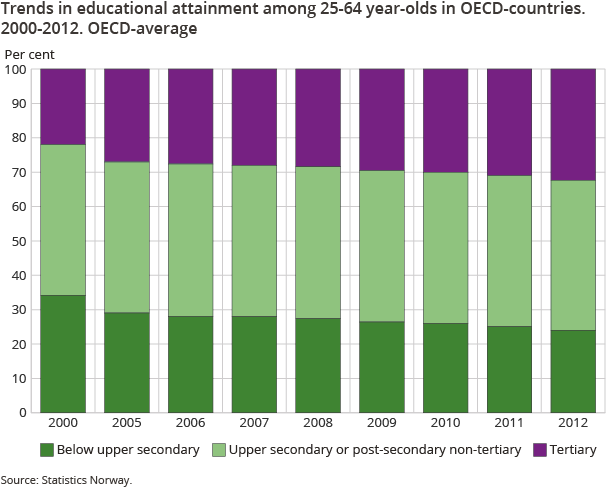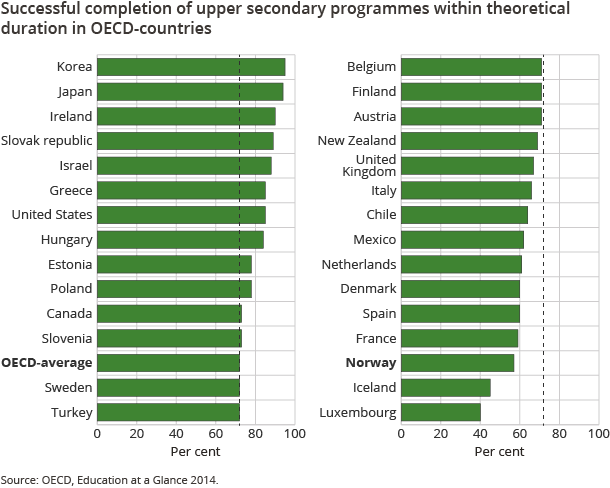Indicators on education in the OECD, academic year 2011/2012
Pupils and students are older in Norway
Published:
In 2012, 15 per cent of pupils who completed an upper secondary study programme in Norway were over 25 years old; one of the highest rates in the OECD and somewhat higher than the average of 5 per cent.
- Series archive
- Indicators on education in the OECD
The OECD’s publication Education at a Glance 2014 shows that 15 per cent of pupils who completed an upper secondary study programme in Norway in the academic year 2011/12 were over 25 years old. In countries like Denmark, Finland, the Netherlands – in addition to Norway – at least 10 per cent were in this age group. In Iceland, 20 per cent of pupils who completed an upper secondary education were older than 25. There were large disparities between general and vocational programmes. Less than five per cent of pupils who completed general programmes were more than 25 years old in 18 out of 27 countries, including Norway. For vocational programmes in Norway, 40 per cent of pupils who completed their study programme were older than 25, while the OECD average was 20 per cent.
The OECD notes that the age of completion is sensitive to any changes in the education system, such as the introduction of new programmes and the lengthening or shortening of programme duration. Some educational systems are quite flexible in providing new opportunities to complete upper secondary education later on in life, leading to disparities in the typical age of pupils completing their studies.
Majority of adults hold an upper secondary qualification…
In recent decades, almost all OECD countries have seen a significant increase in the educational attainment among their population. Tertiary education has expanded markedly, but in most OECD countries a large majority of adults aged 25-64 years has an upper secondary education.
On average, about 45 per cent of adults across OECD countries had attained an upper secondary education as their highest qualification in 2012. In five countries, more than 60 per cent of adults had attained this level of education, while 43 per cent in the age group 25-64 years in Norway had attained an upper secondary education.
The educational attainment trend has been similar in a large number of countries over the last decade; the share of the population aged 25-64 years without an upper secondary education has fallen, and the share of adults holding a tertiary qualification has increased during this period. The share of the population holding an upper secondary qualification as their highest attainment has remained stable.
…but a growing number are attaining a tertiary degree
In OECD countries like Australia, Canada, Ireland, Israel, New Zealand, the Russian Federation, Spain and the United Kingdom, tertiary attainment rates were higher than upper secondary attainment rates in 2012. However, this was not the case in Norway and the other Nordic countries, where between 35-40 per cent had attained a tertiary education. In the period from 2000-2012, the share with a tertiary attainment rose by 10 percentage points as an average across OECD countries for the adult population aged 25-64 years.
In the population aged 25-34 years, the share of people who had attained a tertiary qualification rose by 14 percentage points in this period. Among women this age holding a tertiary degree, there was an increase from 28 per cent in 2000 to 45 per cent in 2012 – an increase of 17 percentage points. For men this age, the increase was from 25 per cent to 34 per cent in the period.
The disparities in attained tertiary education between generations were substantial, and for women in particular in 2012. On average across OECD countries, the share of women aged 25-34 years who had attained a tertiary education was 20 percentage points higher than for women aged 55-64 years. There were large disparities between generations in different countries. In Korea, the difference in tertiary attainment between generations was 61 percentage points in favour of young women – 69 per cent of women aged 25-34 years had earned a tertiary qualification, compared to 8 per cent in the age group 55-64 years. In Norway, 54 per cent of the women aged 25-34 years and 30 per cent of the women aged 55-64 years had attained a tertiary level of education.
7 out of 10 complete upper secondary within theoretical duration
The majority of pupils who start an upper secondary education complete the programme they entered. It is estimated that 72 per cent of young men and women who begin an upper secondary education complete their programme within the theoretical duration of the programme. The share of pupils that complete their education in the stipulated time varies considerably among countries. In Korea, 95 per cent completed an upper secondary education within the theoretical duration. The lowest completion rates were found in Norway, Iceland and Luxembourg.
Successful completion of upper secondary education also depends on how accessible these programmes are. It is reasonable to assume that a higher percentage of pupils will complete their upper secondary education in countries with limited access to this level than in countries that have nearly universal access.
Differences in completion rates between general and vocational programmes
Pupils who enter general programmes are more likely to complete them than those who are enrolled in vocational programmes. Among the 26 countries with available data, 76 per cent of pupils entering a general programme completed within the theoretical duration of the programme. In contrast, only 64 per cent completed their vocational programme within the theoretical duration. There were large disparities in OECD countries in completion rates between upper secondary general and vocational programmes. In Norway, Denmark and Luxembourg, completion rates between the two programmes were at least 30 percentage points. In eight countries, the disparity was less than 10 percentage points.
Young men are less likely to complete on time – in all countries
In all countries with available data, young men are less likely than young women to complete their upper secondary education on time. On average, 76 per cent of young women completed their upper secondary education within the stipulated time, compared to 68 per cent of young men. In Finland, Greece, Ireland, Japan, Korea, the Slovak Republic and Sweden, the disparity in the shares of young men and women who did not complete their upper secondary education was less than five percentage points. In the OECD countries of Iceland, Italy, Norway and Turkey, young women outnumbered young men who successfully completed an upper secondary education by more than 14 percentage points.
In several OECD countries it is relatively common for pupils and apprentices to take a break from their studies and leave the education system temporarily. On average across OECD countries, completion rates within the theoretical duration rise from 72 per cent to 87 per cent when giving two extra years to pupils to complete their upper secondary education. In Norway, the completion rate within the stipulated time went from 57 per cent to 72 per cent when giving an extra two years – an increase of 15 percentage points.
In the same way it is common for pupils in upper secondary education in OECD countries to take a break from their studies, it is also common for pupils to repeat a grade or to change programmes.
These system-level policies and access to employment for people with a low educational attainment could affect successful completion rates.
Contact
-
Geir Nygård
-
Statistics Norway's Information Centre


